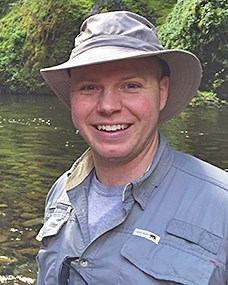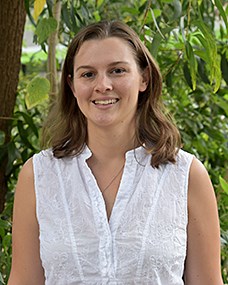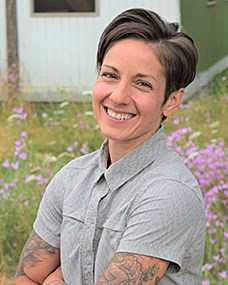Addressing increasing visitor use by integrating social science and resource stewardship
Landscape scale habitat fragmentation, visitor use and associated infrastructure.
Even low-impact recreational activities like hiking, walking, and trail-running can disturb natural areas when there’s a high number of participants, which is common in many of our national parks. The same roads, trails, bridges, and other pieces of infrastructure that allow visitors to enjoy the great outdoors can disconnect and fragment habitats, changing how wildlife and plants behave in the landscape. But so far, few studies have looked at the large scale effects of increased human activity on natural areas and wildlife. This study, in Yellowstone and Rocky Mountain national parks, will use several types of data to learn how high visitor use affects habitat connectivity and fragmentation. Parks will then be able to use this information to strike a science-based balance between recreation and a healthy natural area.

Dr. Evan Bredeweg
Dr. Evan Bredeweg recently earned his PhD from the Department of Fisheries and Wildlife at Oregon State University. He is an ecologist specializing in animal movement and behavior. His dissertation research examined environmental and community factors that shape the movement of recently metamorphosed frogs and explored the implication of these movements in future conditions. Dr. Bredeweg’s research background has ranged from conservation biology of the endangered Tuatara in New Zealand to antipredator behavior of tadpoles. Throughout his research, the dynamic nature of animals interacting with their environment has been a key aspect in his work. Dr. Bredeweg plans to incorporate a perspective of animal behavior into the assessments of the impacts of human-wildlife interaction within national parks. Additionally, he hopes to provide accessible methodologies to allow managers to tailor this approach to their specific priorities.Enhancing ocean and coastal resource stewardship
Identifying, characterizing, and assessing the role of mesophotic coral reef ecosystems in preserving coastal resources in the National Park of American Samoa.
Previous El Nino-induced heat waves led to widespread coral bleaching and coral death in the National Park of American Samoa; rising ocean temperatures is a main threat to its coral ecosystems. Most research in Samoa’s reef ecosystems has focused on shallow coral reefs, less than 30 meters deep. But about 80% of Samoa’s reef ecosystems are deeper, 30-150 meters, and have shown some resistance to coral bleaching. This study seeks to learn more about the deeper coral, most importantly to see if it could be used as a refuge for growing coral that can be used to repopulate the reef. The methods used here can be applied at other national parks facing similar challenges.

Dr. Veronica Radice
Dr. Veronica Radice completed her PhD and first postdoc at the University of Queensland in Brisbane, Australia studying tropical coral reefs of the Indo-Pacific. Her research investigates coral acclimatization to local environmental conditions. She uses field-based experiments and biogeochemical techniques to study how corals acclimatize to shallow versus deep reef environments, with a focus on lower-light mesophotic coral ecosystems. Dr. Radice’s recent work is focused on understanding the impacts of ocean warming on coral recovery following coral bleaching. She completed her bachelor’s degree in Biology at Johns Hopkins University and then worked in a deep-sea coral ecology lab at Temple University. Dr. Radice is excited to join the fellowship studying coral reefs in American Samoa, while based at Old Dominion University.Embracing collaborative conservation at the landscape scale
Enhancing collaborative conservation of an increasingly fragmented metapopulation of desert bighorn sheep.
In California, a huge metapopulation of desert bighorn sheep (DBS) historically comprises many small herds that naturally move through the arid mountains and desert lowlands. They frequently come into contact with each other, allowing gene flow and genetic diversity, and the metapopulation has remained relatively stable and resilient. But new data suggest the metapopulation of DBS faces a number of challenges, including isolation of some herds, effects of climate change, and disease threats among other issues. To effectively address challenges of individual herds, scientists and managers need to understand the condition of the metapopulation in the region. This study will assess how the herds connect and identify potential sites for possible intervention to ensure metapopulation resilience, and it will demonstrate how collaboration among federal and state agencies is necessary to successfully manage conservation at a landscape scale.

Dr. Christina Aiello
Dr. Christina Aiello received a PhD in Ecology from Penn State University as well as a BS in Biology from Elmhurst College. As a U.S. Geological Survey Pathways intern and Penn State doctoral student, she worked collaboratively with numerous federal agencies to conduct management-driven research on the threatened desert tortoise within the Mojave Desert. Her studies focus on applied ecology and examine the connections between human impacts, wildlife behavior and movement, and infectious disease processes within the context of wildlife management. She joined the Epps lab in 2018 to examine bighorn sheep metapopulation connectivity in a desert landscape threatened by increasing fragmentation. Dr. Aiello will use her experience working in desert ecosystems and with various agencies to tie together efforts across management boundaries in order to understand bighorn sheep ecology and inform conservation strategies.Last updated: January 6, 2025
